
 I currently own three cameras, all manufactured by Canon, plus a busted toy Holga "art" camera (modified to accept 35mm film) which I keep for fun.
I currently own three cameras, all manufactured by Canon, plus a busted toy Holga "art" camera (modified to accept 35mm film) which I keep for fun.
My first "serious" camera was a graduation present from my parents in 1984... the Canon A-1. This brilliant camera was the first to have electronically-controlled exposure modes to free the amateur photographer from having to figure out shutter speed and aperture settings. Though primitive by modern standards, I can't stress how revolutionary this was at the time. It allowed me to take professional photographs with virtually no effort from day one... I could concentrate all my attention on composing, lighting, and directing my shots. As I became more experienced, I was able to dial back the automated stuff and use the in-camera metering to select my own settings...
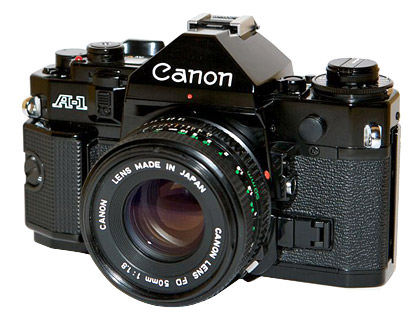
This camera is responsible for me falling in love with photography, and I took it everywhere for two decades. Rugged, dependable, and capable of amazing photos, I spent a good chunk of my income buying and developing rolls of 35mm film over the years. When the "digital revolution" arrived, I played around with a few digital cameras (most notably, the Apple QuickTake 100 in 1993), but they all shot crap compared the the beautiful images coming out of my Canon A-1. Believe it or not, I still burn an occasional roll in it to this day. As good as digital is, there's something primal about shooting film. Images shot with it aren't a bunch of 1's and 0's, but a chemical reaction you have to control. The satisfaction of getting a good shot with film is unlike any other.
But all good things come to an end.
In 2003 I was dragged kicking and screaming into the digital age when I bought the first affordable SLR camera... the Canon EOS Digital Rebel (also known as the EOS 300D). By this time, professional digital cameras were available but very expensive. I coveted the Canon 10D, but it was $1800... no lens included! I managed to get the Digital Rebel for $900 including a decent 18-55mm lens. At 6.3 megapixels, it transcended the "toy" status of other cameras I could afford, and everything I read about it was encouraging...
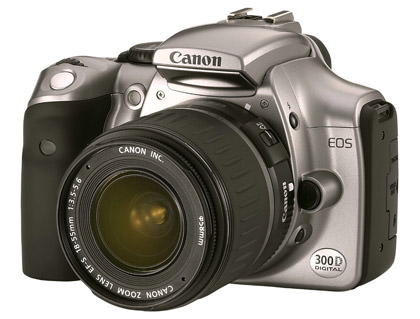
This has been my primary camera for the past five years. I never fell in love with it like I did my Canon A-1, but the Digital Rebel has been a wonderful camera, faithfully accompanying me on travels around the world. It's rugged, dependable, takes decent photos, and is easy to use with its many automated modes (plus full auto). Once I added my dream lens (the Canon 16mm-35mm wide-angle zoom), I was finally able to take the photos I was imagining in my head.
Because the Digital Rebel is fairly bulky, I bought a Canon PowerShot S400 Elph just one month later. It was an okay camera, but it wasn't until I replaced it with the Canon PowerShot SD800-IS in December 2006 that I fell in love with pocket digital cameras (it was the image stabilization that did it). I carry this camera with me absolutely everywhere and can't imagine life without it.
I never bought into the idea that more megapixels give you noticeably better images (unless you blow them up really big), so I never saw a need to replace my Digital Rebel. With the high-quality optics of my dream lens, the 6.3 megapixels are plenty for everything I need. Even 11x17 prints turn out beautifully, so why spend money on a new camera?
Well...
Not only have I found a camera that has convinced me to "upgrade"... but also to switch from Canon to Nikon after 22 years of Canon loyalty. Introducing the Nikon D90...
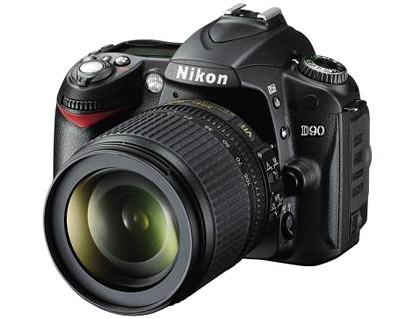
Sure it has all the cutting edge bells and whistles that make it an amazing camera. Nikon is a world leader in photography, so you'd expect it to be cutting edge. It even has the ground-breaking ability to shoot video. But adding video... even sweet video that can be shot through SLR lenses and have variable depth-of-field like a movie camera... wasn't reason enough for me to break with Canon and replace my Digital Rebel. Bells and whistles are fun, but they don't magically turn bad pictures into great pictures.
Then along comes "Active D-Lighting."
Far from a gimmick, this miracle feature applies live metering adjustments to an image to assist in opening up deep shadow areas, while also working to recover detail from blow-outs. It's not the ideal solution for dealing with problems like this, but it's an amazing accomplishment that's all happening before you even press the shutter release. The sample on Nikon's site is pushed a bit too far for my tastes, but you get the idea. Here's a shot with Active D-Lighting OFF...
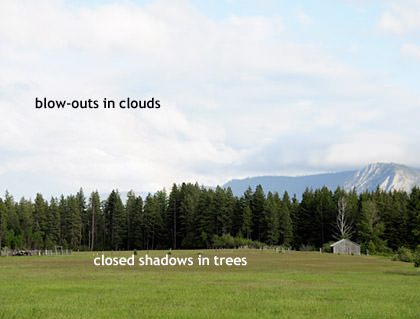
And here's with Active D-Lighting ON...
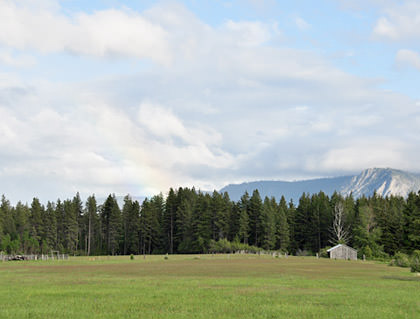
Pretty sweet. Cloud detail has been restored (including a rainbow!), plus some detail in the tree shadows too. A good photographer can always adapt to a scene given a decent camera, enough time, the right filters, and experience... but for random shooting where you're fighting to get a shot in a hurry, Active D-Lighting is an incredibly handy thing to have available (as illustrated here). It appears to be a better, more natural-looking alternative than messing around with the "Shadow/Highlight Filter" and manipulating curves in Photoshop after the fact.
Once you add Active D-Lighting to the many other features of this remarkable camera, it's just compelling enough to make me take the leap. So I'm taking the money I'll be getting from the sale of my motorcycle and sinking it into a Nikon D90. Sadly, it won't arrive in time for my upcoming vacation, but I'm anxious to play around with it when I get back just the same.
Having something to look forward to when you're coming back from vacation is nice.

I love comments! However, all comments are moderated, and won't appear until approved. Are you an abusive troll with nothing to contribute? Don't bother. Selling something? Don't bother. Spam linking? Don't bother.
PLEASE NOTE: My comment-spam protection requires JavaScript... if you have it turned off or are using a mobile device without JavaScript, commenting won't work. Sorry.

Welcome to the world of Nikon my friend. I have four of them now. Love them all.
Happy shooting.
Cool, although I´m not ready to take the leap. I am eagerly awaiting the upgrade on the 5D that´s supposed to be out sometime this fall. My experience is that Canon lences are outstanding in a way Nikon really can´t compete with. It would be hazardous to my finances to start all over too.
i love my nikkon, although it is nothing like your fancy schmancy one. hope it brings you years of phenomenal photos. enjoy!
(and thanks for the lesson.)
I just got my very first SLR camera and I’ve been pretty stoked about it (it’s the Nikon D50)
So I’m going to pretend I didn’t just read about the awesomeness of D-Active Lighting.
I never got the photo bug, and at those prices, I’m glad I didn’t! I’m just glad I have friends who did.
I have an A-1!
I’ve yet to play with it…I guess I need to!
Do you know how well digital prints are supposed to hold up over time? I have some 37-year old photos that may be faded (I can’t tell … they look fine) and I’ve wondered about the digital shots I take of my kids today — will those photos be around in 37 years?
There are times I wonder if I should get a film-based camera. Digital is just so easy … I can upload to Snapfish and collect the photos at Walgreen’s three hours later.
My camera history is a bit different from yours, though there are some similarities. I nearly got an SLR in the mid- to late- ’80s, but didn’t. Instead, I stuck with my cheap 110 camera for a while and then got an automatic (non-SLR) 35mm in the early ’90s. Experimented a bit with borrowed digitals in ’97 (unimpressive) and ’99 (better).
I went ahead and made the jump to digital in mid-’99 with an Olympus 3x zoom. Later, upgraded to the peerless Olympus 2100 UZ. It was really with the Uzi that I fell in love with photography.
Finally, just before Christmas, 2003, I made the jump and got the Digital Rebel. Revolutionary. I learned a lot over the next year, along with buying a few relatively inexpensive lenses. In early 2005 I sold the Rebel, some lenses and some other accessories to a friend for about the cost of the new Rebel XT. As good as the Rebel was, it paled in comparison to the XT in speed and noise performance.
This March, I stepped up to the 40D. I’d been contemplating the jump to the next model level since the 20D, and had really planned on getting the 30D once the 40D came out and lowered the 30D price a bit. But, predictably, I couldn’t resist the extra features of the 40D. I love it.
At this point, my plan is to stick with the 40D for a long time. I’m not particularly tempted by the 50D (though ISO 12800 is a start) or the Nikon D90. A big jump in ISO performance would probably be my weakness, say a 4 stop improvement at the same level of noise as the 40D.
Oooh… then I have bad news for you.
The D90 has been upgraded with a new CMOS sensor that Nikon says will produce the same quality image at ISO 6400 (expanded) that you can get from the D300. All at 12.9 megapixels.
🙂
Of course, my brother has a D40, and it really is an amazing camera, so I can see your reluctance in parting with it. With the exception of having an auto-focus motor in the body, I don’t think anything that came after it would really be worth the upgrade… unless it’s possibly the D90 with that amazing Active D-Lighting.
It was a very tough decision for me, but given how so much of my photography is “on-the-go,” the flexibility options of the D90 were just too much to pass up.
My first real camera was an SLR by Ricoh (don’t recall the model offhand) that I lugged all over for 15 or so years while accumulating all sorts of accessories for it. Pretty rugged until I had to start smacking the bottom of it to release the mirror near the end.
It became unreliable just as I started a major cross country trip. Fixing the body was going to cost hundreds and take weeks, so my dad sent me his abandoned Nikon 2020 SLR, and I’ve had it since. I hate its slow 35-70mm lens (my Ricoh had a 28-70mm that was nearly a stop faster).
I tend to borrow my parents’ P&S digital cameras nowadays. Pocket-sized has great appeal, but shutter lag and the inability to focus by rotating a ring drive me nuts. Do your DSLR lenses have DOF marks on them? The ones I’ve seen never do.
Your newest camera sounds pretty cool, so maybe it’s time for me to start looking again.
I love my Nikon d40! I just got it a few months ago. I think it has that feature but it’s not active, you do it afterward? I pretty much touch up everything in Photoshop anyway, which probably sacrilegious to a “real” photographer. I don’t care, I’ve got some great pictures I’ve framed up on the walls and people ask me who the photographer was!
I think I will stay with the d40 until I can afford a d300, a far away dream at the moment.
Video? It does video? SWEET!
But wait, this is costing you the entire sale of your motorcycle or just a portion of it?
I don’t own a DSLR yet, but have read a lot about the new D90.
I’ve had a loyalty to Pentax, which I’ve used the brand for last 25 years. I’m looking at the K200D and K20D models now. I was eying the K100D Super, but at only 6MP, that seems small for today’s needs.
I’ve always been Nikon’s bitch. My uncle was an amateur photographer and always used Nikon cameras. So, I guess you could say it’s a family thing. 🙂 Glad you’re happy with yours.
You’ve managed to sell me on my next camera. So thank you. My wallet however, does not thank you.
Awww, I am so disappointed to hear you’re leaving the Canon family. I understand why, but I was the exact opposite – a loyal Nikon fan until a few years ago when I made the switch to Canon. I hope you enjoy your new camera though! And check into shooting RAW only. You will never go back, trust me.
I’m sticking with my Polaroid (click, whine).
Maybe someday when I’m a bit more of a pro I’ll look into one of those higher-end cameras — right now I’m pretty happy with my entry level Canon Rebel Xsi. And I can’t wait to talk shop with some of my favorite photographers next month.
When Is tarted in professional photography way back when I had Canon’s and a couple of the A-1’s, went through Nikons, Olympus, Leica, Hasselblad.
Now digital, back to Canon.
I have a D40 that I absolutely love – it’s a workhorse (although it’s not as nice as the 90).
Motley’s dad is a professional photographer who takes air to air photos of military jets. He’s one of the best civilian aviation photogs in the world. He was a Nikon man for many years shooting film. When it came time to move to the digital world… he spent more than $20K on… Canon. (I know how much he spent because I had to explain to him what a capital expense was.) Funny how he took the opposite road to yours.
Rebel XT here. Works well for my needs.
Dave,
That imaging tech sounds cool, but it also sounds like something that could easily be solved by using a polarizer on the lens. That example pic is the perfect candidate for polarization, and it might even pop those greens and blues out a bit. Save the cash on the new body and grab up a few filters. Don’t leave Canon, Dave!
I shoot wide angle a lot, and polarizers don’t work so well with wide angle because the lighting changes across that big of an area.
I need something to get me interested in photography again, and maybe switching to Nikon will do it for me!
Yay! I am in love with you moving to the way of Nikon. The D90 is a fantastic camera especially at moderately high ISO. It’s a fantastic choice.
If you REALLY wanna prevent “blow out” in scenes with clouds and other extremes, try doing some HDR. Capture everything and display everything.
If you ever wanna geek out on Nikon/photography I’m only an IP address away!
I have a Sony Digital SLR Camera (not able to remember the model) and i am totally in love with it . It is obviously better than my other 2 cameras in which i had to set the focus manually .